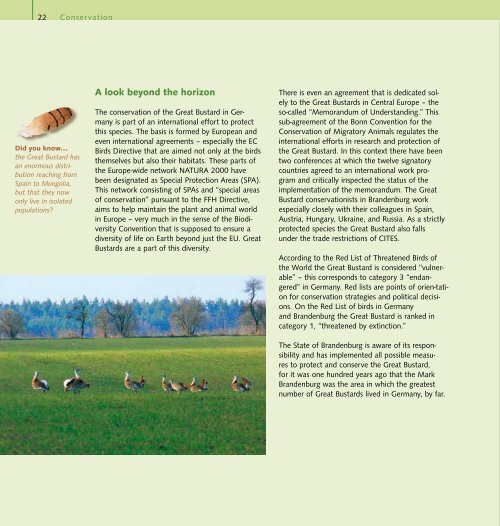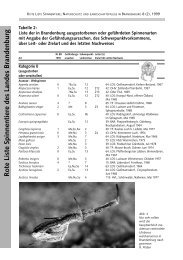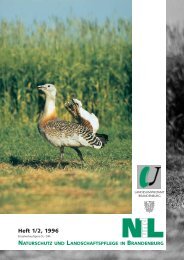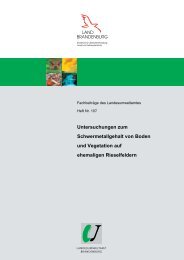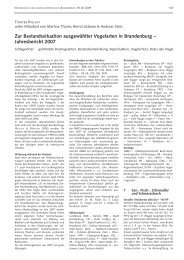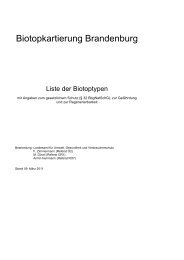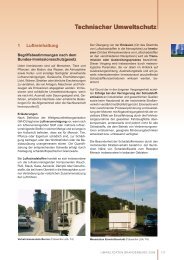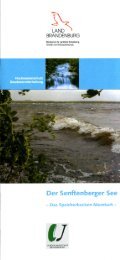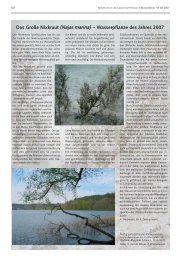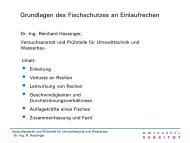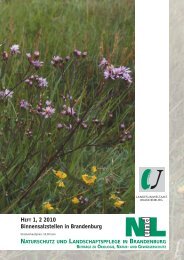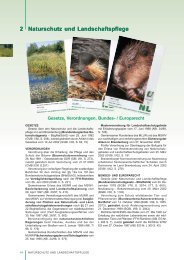the Brandenburg ostrich - Landesamt für Umwelt, Gesundheit und ...
the Brandenburg ostrich - Landesamt für Umwelt, Gesundheit und ...
the Brandenburg ostrich - Landesamt für Umwelt, Gesundheit und ...
You also want an ePaper? Increase the reach of your titles
YUMPU automatically turns print PDFs into web optimized ePapers that Google loves.
22ConservationDid you know...<strong>the</strong> Great Bustard hasan enormous distributionreaching fromSpain to Mongolia,but that <strong>the</strong>y nowonly live in isolatedpopulations?A look beyond <strong>the</strong> horizonThe conservation of <strong>the</strong> Great Bustard in Germanyis part of an international effort to protectthis species. The basis is formed by European andeven international agreements – especially <strong>the</strong> ECBirds Directive that are aimed not only at <strong>the</strong> birds<strong>the</strong>mselves but also <strong>the</strong>ir habitats. These parts of<strong>the</strong> Europe-wide network NATURA 2000 havebeen designated as Special Protection Areas (SPA).This network consisting of SPAs and “special areasof conservation” pursuant to <strong>the</strong> FFH Directive,aims to help maintain <strong>the</strong> plant and animal worldin Europe – very much in <strong>the</strong> sense of <strong>the</strong> BiodiversityConvention that is supposed to ensure adiversity of life on Earth beyond just <strong>the</strong> EU. GreatBustards are a part of this diversity.There is even an agreement that is dedicated solelyto <strong>the</strong> Great Bustards in Central Europe – <strong>the</strong>so-called “Memorandum of Understanding.” Thissub-agreement of <strong>the</strong> Bonn Convention for <strong>the</strong>Conservation of Migratory Animals regulates <strong>the</strong>international efforts in research and protection of<strong>the</strong> Great Bustard. In this context <strong>the</strong>re have beentwo conferences at which <strong>the</strong> twelve signatorycountries agreed to an international work programand critically inspected <strong>the</strong> status of <strong>the</strong>implementation of <strong>the</strong> memorandum. The GreatBustard conservationists in <strong>Brandenburg</strong> workespecially closely with <strong>the</strong>ir colleagues in Spain,Austria, Hungary, Ukraine, and Russia. As a strictlyprotected species <strong>the</strong> Great Bustard also falls<strong>und</strong>er <strong>the</strong> trade restrictions of CITES.According to <strong>the</strong> Red List of Threatened Birds of<strong>the</strong> World <strong>the</strong> Great Bustard is considered “vulnerable”– this corresponds to category 3 “endangered”in Germany. Red lists are points of orien-tationfor conservation strategies and political decisions.On <strong>the</strong> Red List of birds in Germanyand <strong>Brandenburg</strong> <strong>the</strong> Great Bustard is ranked incategory 1, “threatened by extinction.”The State of <strong>Brandenburg</strong> is aware of its responsibilityand has implemented all possible measuresto protect and conserve <strong>the</strong> Great Bustard,for it was one h<strong>und</strong>red years ago that <strong>the</strong> Mark<strong>Brandenburg</strong> was <strong>the</strong> area in which <strong>the</strong> greatestnumber of Great Bustards lived in Germany, by far.


